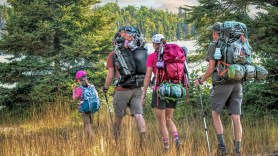

Rivers can offer a route to safety if you are lost, and though they may not look dangerous at first, a river can be unpredictable and quickly change in an instant. Melting snow from a mountain, or flooding in heavy rain can cause flash floods, or the river surface might look calm but underneath there are powerful currents and holes.
Videos by Outdoors
“I’ve seen rivers that look absolutely fine; a quarter of an hour later, they’re wild and treacherous,” says Bear Grylls in How to Stay Alive. “If you’re going to risk crossing them, you need to know what you’re doing.”

Entering The River
When planning to cross a river, choose the entry point carefully. It’s better not to jump into the water from rocks or a bank – you are not sure what will be underneath, and if the water is shallow or has sharp rocks, you might break an ankle or leg.
Wade into a river slowly if you can – from a ‘beach’ where you can easily access the water. Beware though – if you can access the water easily, so can animals. “In extreme environments, where dangerous animals are commonplace, the perfect crossing
point could also be the most dangerous,” says Bear in How to Stay Alive.
Keep your sense of awareness and look out for any threats. Get into the water quickly and always be aware of the power of the river. You do not want to wade in and then get overpowered by the flow or not be able to get out. It is better to have a plan first and an exit strategy if you need one. Throwing a log into the water to see how fast it flows away from you, and which direction can provide some sense of things, before you step in.

Exiting The River
Once you have crossed the river, you need to make sure you can get out on the other side – arriving at a shallow area rather than where there are steep banks or cliffs. As you will probably move downstream with the current, you will probably not be getting out of the river opposite where you entered. “Don’t risk making the crossing if you don’t know how you’ll get out of the river,” says Bear.
Carrying a Rucksack
Undo the waist strap of any rucksack and take one arm out – even in knee-deep water. If you hit a hole, a rucksack can drag you under or force you face-down into the water. If you have the backpack half-slung, you can get rid of it if you have to, or use it as a buoyancy aid.
If you have read what Bear Grylls packs in his survival backpack, you will have all of your gear wrapped up well and waterproofed. If there’s air in the rucksack, it should float.

Crossing The River
The best way to cross the river, if the water is shallow and you can keep your feet on the bottom, is to face up the river and side-step across the current. You can use your leg muscles to stop the river taking your legs away. Cross with small steps, so that you feel any changes in the river bed. “Don’t ever cross your feet over, as this reduces your stability and makes you liable to trip,” says Bear.
He advises that you find a strong branch, long enough to hold at a 45° angle with one end over your shoulder and the other end on the ground. This will give you an extra brace, for stability.
Dealing With Fast-Moving Currents
Beware of the hidden power that a river can have – remember things like rapids and white water. Branches, tree trunks, and other things coming downstream can also be dangerous, especially if they hit you on the head.

Dealing With Slow-Moving Currents
These can also be dangerous – with everything from rocks to animals, posting a threat. If the water is deep, it’s tricky to get across, especially if you have a backpack. Bear advises the best strategy is to remove all clothing and swim across naked. “You can’t swim effectively with lots of heavy clothes, and you won’t need your boots for stability,” he says.
Store your clothes and boots in your backpack, sealed up as much as you can (wrap it up in a bivi sheet or tarp if you have one). This can also double as a buoyancy aid, and you’ll have dry clothes on the other side. If you are wading in the river, keep your boots on to help avoid any sharp rocks on the riverbed.

If You Fall In
If you fall in or lose your footing, and are being swept downstream, position yourself on your back, with your feet facing downstream, and your hands behind your head. Be ready to fend off any rocks in the river, or to push any loose debris out of the way.
The river will carry you along the main route of flow – which is not good. Look out for any eddies where the flow slows or doubles back on itself, for example at an obstacle. “These areas of slower-moving water to the sides are life-savers,” says Bear. “When you see one, swim like hell for it.”
You might have to ‘punch’ through the eddy-line, where the two different directions of river flow cross, so you will need to give a surge of power to cross into the slower water.
Don’t Use Ropes
Finally, Bear says that ropes don’t really work with river crossings (unless they are special water-safety floating ropes) as they sink or get wrapped around your body or other obstacles.









